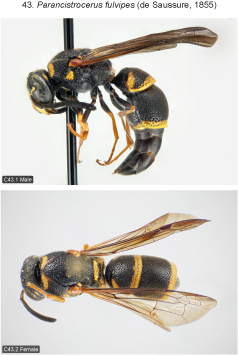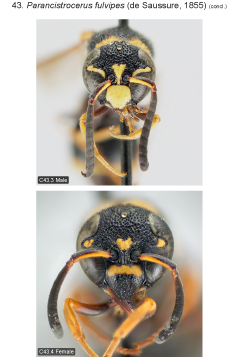
| Home | Table of contents | Keys | Species list | Glossary | Image data | PDF | Cite this article | Feedback | Updates |
Identification Atlas of the Vespidae (Hymenoptera, Aculeata) of the northeastern Nearctic region
CJAI 05, February 19, 2008
doi: 10.3752/cjai.2008.05
Matthias Buck, Stephen A. Marshall, and David K.B. Cheung
Department of Environmental Biology, University of Guelph, Guelph, Ontario, Canada N1G 2W1
Next species | Previous species | Key
43. Parancistrocerus fulvipes (de Saussure, 1855)
Figs B7.30, 52; C43.1–4.
Stenodynerus (Parancistrocerus) vogti Krombein, 1962, new synonymy

|

|
Taxonomic note. Parancistrocerus vogti was described from a single, malformed female (wings deformed) reared from a trap nest from Plummers I., Maryland (holotype at USNM) and has apparently never collected since. Examination of the holotype suggests that it represents a stunted, abnormally developed specimen of P. fulvipes, a common species in Maryland. The specimen agrees with all the diagnostic characters of P. fulvipes mentioned in the key and following paragraph. It furthermore possesses a very deep acarinarium, another character typical for P. fulvipes. We interpret the differences between the holotype of P. vogti and normal P. fulvipes females (i.e., size only about 0.6x the normal size; transverse basal groove of sternum 2 with numerous longitudinal ridges; disc of sternum 2 not sloping down towards basal groove, more or less straight in profile and more or less at same level with groove; tergum 1 shortened) as developmental abnormalities, possibly as a consequence of malnourishment.
Species recognition. This species can only be recognized by a combination of characters. Tergum 1 with well-developed discal spots, but discal spots completely absent from tergum 2. This colour pattern is otherwise only found in a few specimens of P. bicornis and P. vagus (both species usually have yellow spots on tergum 2). Parancistrocerus fulvipes differs from the former by the absence of a small, eye-lid like swelling behind the mid ocellus, and the presence of an anteroventral depression near the base of the male mid femur. It can be distinguished from P. vagus by the presence of a strongly developed transverse carina near the summit of tergum 1 followed by a smooth area, and the absence of several characters unique to P. vagus (see under that species). Further diagnostic characters of P. fulvipes are: male flagellum dark beneath except sometimes basal segment(s), which can be obscure reddish; interocellar tubercles between hind ocelli well-developed, especially in male; pronotal carina developed medially but low; posterior half of tergum 1 convex in lateral view (shared to a lesser degree by P. vagus, P. bicornis, P. salcularis); terga without apical fasciae beyond tergum 2 except sometimes in male; hind margin of tergum 2 slightly (female) to moderately (male) thickened.
Variation. Fore wing length 5.5–8.0 mm (♂♂), 7.5–8.5 mm (♀♀). Variation otherwise not studied.
Distribution. Not recorded from Canada. Eastern U.S. west to MI, IL, KS, OK, TX (Krombein 1979). Mexico: Tamaulipas (Rodríguez-Palafox 1996). The reddish form that occurs from SC to FL was named ssp. rufovestis (Bohart, 1948).
Biology. This species uses a variety of pre-existing nest sites such as borings in wood, old mud dauber and Polistes nests, and abandoned burrows of ground-nesting bees, but it may also construct its own burrows in the ground. Mud or agglutinated sand is used for closing plugs and nest partitions. Prey are caterpillars of Tortricidae, Nolidae (Chloephorinae; formerly in Noctuidae), Crambidae (Pyraustinae) and Gelechiidae (Krombein 1967, 1979; Nelson 1968).
Next species | Previous species | Key
| Home | Table of contents | Keys | Species list | Glossary | Image data | PDF | Cite this article | Feedback | Updates |
